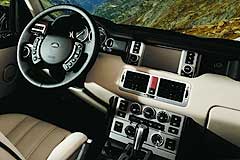Future models - Land Rover - Range RoverFirst look: Range Rover's heart transplantFording ahead: Range Rover gets Jaguar V8s to replace BMW petrol engine. The original luxury SUV has more power and more equipment for 20054 Dec 2004 By BRUCE NEWTON THE Ford-ification of Land Rover continues apace in 2005 with the luxury Range Rover trading in its expensive BMW 4.4-litre petrol engine for a pair of Jaguar-sourced V8s. However, the expected swap from BMW 3.0-litre turbo-diesel inline six to the new 2.7-litre Ford-Peugeot developed V6 has not taken place. This first significant update of the third generation Range Rover includes minor exterior restyling including new grille and bumper, but few changes inside. There are also new technologies being offered, including rear-view camera, adaptive headlights, tyre-pressure monitoring and touch-screen control for navigation, audio, phone and off-road driving information. The two new V8s are very much the stars of the show and are a logical step for Ford, which bought Land Rover from BMW in 2000 and also owns Jaguar. The headline act is the supercharged 4.2-litre engine that already sees duty in the Jaguar S-Type, XJ and XK. In the Range Rover it produces 291kW and 560Nm. The normally aspirated V8 is a 4.4-litre update of the 4.2 that has yet to flow into any production Jaguar models. Already seen in the new Discovery, it produces 225kW and 427Nm. Both engines are also being offered in the new Range Rover Sport, which like the new Range Rover, will have its first public viewing at the Detroit auto show this month. Both cars will be on-sale in Australia during 2005, the Range Rover on July 1 and the Sport late in the second half. Both will follow the all-new Discovery on-sale, which we should see in April. The Range Rover is expected to have some model changes and increased pricing when it goes on-sale. Both new engines outdo the 210kW BMW 4.4 for power, but the German unit is better on torque with 440Nm than the new normally aspirated V8. Nevertheless, Land Rover claims both new petrol engines are quicker to 100km/h than the BMW V8, the supercharged by a massive 1.5 seconds and the normally aspirated by 0.5 seconds. The new engines are also claimed to offer better NVH (Noise, Vibration and Harshness) qualities than their predecessor, and are also supposed to be better isolated from the interior. Engine details include double overhead camshafts with variable phasing on the naturally aspirated, 32 valves, drive by wire throttle and sophisticated torque-based engine management systems. Specific modifications for Land Rover include a wider spread of torque, the ability to operate at extreme angles, better water-proofing and increased protection from dust and rocks. The new engines are matched to the latest-generation ZF six-speed automatic transmission. It uses a centre differential (now electronically controlled) to transfer torque, while low-range completes the off-roading package.  Land Rover has developed the Range Rover's steering and air suspension further, while the supercharged version gets performance Brembo front brakes and a sportier chassis set-up. Land Rover has developed the Range Rover's steering and air suspension further, while the supercharged version gets performance Brembo front brakes and a sportier chassis set-up.The supercharged also gets its own additional styling modifications, which include mesh-design front grille and power vents, and unique 20-inch alloy wheels. Range Rover pricing
Motor industry news |
Click to shareLand Rover modelsRange Rover pricing
Motor industry news |














Facebook Twitter Instagram